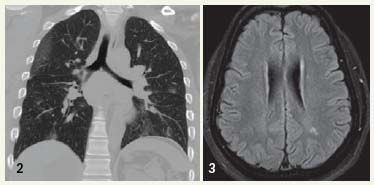Intramedullary Spinal Sarcoidosis Myelopathy
A 46-year-old African American man presented to the neurology clinic with a three-month history of right-side upper/lower extremity weakness/parasthesias that progressed to involve the left side.
CLINICAL HISTORY
A 46-year-old African American man presented to the neurology clinic with a three-month history of right-side upper/lower extremity weakness/parasthesias that progressed to involve the left side. Past medical history was significant only for hemoglobin C trait. Chest radiographs, chest CT scan, MR images of the brain and cervical and thoracic spine were obtained. Serum angiotensin converting enzyme (ACE) level was elevated 93 U/L. The patient underwent mediastinoscopy and lymph node biopsy, which showed noncaseating granulomas consistent with sarcoid. Pulse-dose steroids and rituximab brought gradual neurological improvement.
FINDINGS

The frontal chest radiograph showed bilateral hilar prominence (Figure 1). CT of the chest demonstrated scattered bilateral ground glass opacities (Figure 2). High-intensity T2 signals from the MRI brain showed a few nonspecific white matter lesions in the left frontal and parietal lobes. There was no abnormal parenchymal or leptomeningeal enhancement (Figure 3). Increased T2 signal from the cervical/thoracic spine indicated prominent elongated intramedullary sarcoidosis from C2 through T3-T4, underlying central canal stenosis at C5-C6 and C6-C7 and mild leptomeningeal/intramedullary enhancement at C5-C6 (Figures 4 and 5).
DIAGNOSIS
Intramedullary spinal sarcoidosis myelopathy.
DISCUSSION

Sarcoidosis is an idiopathic disease associated with noncaseating granuloma formation. It can affect multiple organs throughout the body, most notably the lungs and lymph nodes. It usually presents in patients between the ages of 20 and 40 years. African Americans are affected more often, women more often than men. Fifty percent of patients can be asymptomatic at diagnosis, 25% develop cough/dyspnea. Clinical central nervous system (CNS) involvement occurs in approximately 5% of patients; however, it is found 25% of the time at autopsy. Intramedullary sarcoidosis is rare and occurs in less than 1% of cases.
The clinical presentation of neurosarcoidosis is nonspecific but is usually related to granulomatous involvement of the basal meninges that subsequently affects the cranial nerves. Leptomeningeal involvement occurs in approximately 40% of cases, characterized by abnormal thickening and enhancement. Nonspecific high-signal T2 periventricular white matter lesions are the most frequent intraparenchymal MRI finding.

Intraspinal sarcoid was classified by Junger et al into four stages. In phase 1, the spinal cord is normal in size and demonstrates linear leptomeningeal enhancement. In phase 2, presumed spread of leptomeningeal inflammation through Virchow-Robin spaces results in diffuse spinal cord enlargement with early faint enhancement. With phase 3, there is a decrease in cord swelling and presence of focal/multifocal enhancement. Finally, in phase 4, there is no more enhancement and the cord can become normal size or atrophic.
The differential diagnosis for intramedullary neurosarcoidosis can be quite long and includes demylinating disease, tumor, infection, infarct, and vasculitis. In this case, even though there is no direct CNS histology, the abnormal chest imaging, elevated serum ACE, and positive lymph node histology classify the findings as probable neurosarcoidosis.
Myelopathy from intramedullary neurosarcoidosis can be the initial clinical presentation of this disease. It is important to keep this in mind in the appropriate clinical setting.
Igor Sirotkin, M.D. and Nicole D. Melendez, M.D., are radiologists with Bay Pines VA Medical Center in Bay Pines, Florida.
This material is based on work supported by the Department of Veterans Affairs, Veterans Health Administration, Department of Internal Medicine and Department of Radiology, and the Office of Research and Development. This material is the result of work supported with resources and the use of facilities at the Bay Pines VA Healthcare System.
BIBLIOGRAPHY
Junger SS, Stern BJ, Levine SR, et al. Intramedullary spinal sarcoidosis: Clinical and magnetic resonance imaging characteristics. Neurology 1993;43(2):333-337.
Miller BH, Rosado-de-Christenson MI, McAdams HP, et al. Thoracic sarcoidosis: radiologic-pathologic correlation. RadioGraphics 1995;15(2):421-437.
Nowak DA, Widenka DC. Neurosarcoidosis: a review of its intracranial manifestation. J Neurol 2001;248(5):363-372.
Pawate S, Moses H, Sriram S. Presentations and outcomes of neurosarcoidosis: a study of 54 cases. Q J Med 2009;102(7):449-460.
Smith JK, Matheus MG, Castillo M. Imaging manifestations of neurosarcoidosis. AJR 2004;182(2):289-295.
Zajicek JP, Scolding NJ, Foster O, et al. Central nervous system sarcoidosis-diagnosis and management. Q J Med 1999;92(2):103-117.
GE HealthCare Debuts AI-Powered Cardiac CT Device at ACC Conference
April 1st 2025Featuring enhanced low-dose image quality with motion-free images, the Revolution Vibe CT system reportedly facilitates improved diagnostic clarity for patients with conditions ranging from in-stent restenosis to atrial fibrillation.
The Reading Room Podcast: Current Perspectives on the Updated Appropriate Use Criteria for Brain PET
March 18th 2025In a new podcast, Satoshi Minoshima, M.D., Ph.D., and James Williams, Ph.D., share their insights on the recently updated appropriate use criteria for amyloid PET and tau PET in patients with mild cognitive impairment.